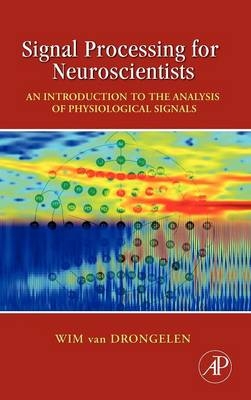
Signal Processing for Neuroscientists
Academic Press Inc (Verlag)
978-0-12-370867-0 (ISBN)
- Titel erscheint in neuer Auflage
- Artikel merken
Signal Processing for Neuroscientists introduces analysis techniques primarily aimed at neuroscientists and biomedical engineering students with a reasonable but modest background in mathematics, physics, and computer programming. The focus of this text is on what can be considered the ‘golden trio’ in the signal processing field: averaging, Fourier analysis, and filtering. Techniques such as convolution, correlation, coherence, and wavelet analysis are considered in the context of time and frequency domain analysis. The whole spectrum of signal analysis is covered, ranging from data acquisition to data processing; and from the mathematical background of the analysis to the practical application of processing algorithms. Overall, the approach to the mathematics is informal with a focus on basic understanding of the methods and their interrelationships rather than detailed proofs or derivations. One of the principle goals is to provide the reader with the background required to understand the principles of commercially available analyses software, and to allow him/her to construct his/her own analysis tools in an environment such as MATLAB®.
Wim van Drongelen studied Biophysics at the University Leiden, The Netherlands. After a period in the Laboratoire d'Electrophysiologie, Université Claude Bernard, Lyon, France, he received the Doctoral degree cum laude. In 1980 he received the Ph.D. degree. He worked for the Netherlands Organization for the Advancement of Pure Research (ZWO) in the Department of Animal Physiology, Wageningen, The Netherlands. He lectured and founded a Medical Technology Department at the HBO Institute Twente, The Netherlands. In 1986 he joined the Benelux office of Nicolet Biomedical as an Application Specialist and in 1993 he relocated to Madison, WI, USA where he was involved in research and development of equipment for clinical neurophysiology and neuromonitoring. In 2001 he joined the Epilepsy Center at The University of Chicago, Chicago, IL, USA. Currently he is Professor of Pediatrics, Neurology, and Computational Neuroscience. In addition to his faculty position he serves as Technical and Research Director of the Pediatric Epilepsy Center and he is Senior Fellow with the Computation Institute. Since 2003 he teaches applied mathematics courses for the Committee on Computational Neuroscience. His ongoing research interests include the application of signal processing and modeling techniques to help resolve problems in neurophysiology and neuropathology. For details of recent work see http://epilepsylab.uchicago.edu/
Chapter 1: Introduction
Chapter 2: Data Acquisition
Chapter 3: Noise
Chapter 4: Signal Averaging
Chapter 5: Real and Complex Fourier Series
Chapter 6: Continuous, Discrete, and Fast Fourier Transform
Chapter 7: Fourier Transform Applications
Chapter 8: LTI Systems, Convolution, Correlation, and Coherence
Chapter 9: Laplace and z-Transform
Chapter 10: Introduction to Filters: The RC Circuit
Chapter 11: Filters: Analysis
Chapter 12: Filters: Specification, Bode Plot, and Nyquist Plot
Chapter 13: Filters: Digital Filters
Chapter 14: Spike Train Analysis
Chapter 15: Wavelet Analysis: Time Domain Properties
Chapter 16: Wavelet Analysis: Frequency Domain Properties
Chapter 17: Nonlinear Techniques
References
Index
| Erscheint lt. Verlag | 18.12.2006 |
|---|---|
| Verlagsort | San Diego |
| Sprache | englisch |
| Maße | 152 x 229 mm |
| Gewicht | 600 g |
| Themenwelt | Medizin / Pharmazie ► Medizinische Fachgebiete |
| Naturwissenschaften ► Biologie ► Humanbiologie | |
| Naturwissenschaften ► Biologie ► Zoologie | |
| ISBN-10 | 0-12-370867-2 / 0123708672 |
| ISBN-13 | 978-0-12-370867-0 / 9780123708670 |
| Zustand | Neuware |
| Haben Sie eine Frage zum Produkt? |
aus dem Bereich



